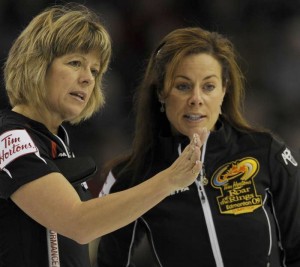Around the House: Curling clubs get the academic treatment
Recreational curlers may not be aware, but our activities have been put under a research microscope recently.Don’t let that scare you, though. Hockey – Canada’s other big-ticket sport played on ice – certainly receives its share of attention in the media and from academia. Why shouldn’t we curlers get our turn?
So who’s doing the research, and what are they finding?
Let’s start with Dr. Heather Mair, associate professor in the Department of Leisure Studies, University of Waterloo. Dr. Mair has been featured on the Canadian Curling Association website before (read about her, here), and I recently had the opportunity to talk to her while researching an article for Canadian Geographic magazine about the importance of curling clubs in small communities.
Curlers know just how important our clubs are, whether we’re small-town or city dwellers. Our clubs are a social centre, a recreation focal point, and frequently the site of community events like wedding receptions, fund raisers and other celebrations.
And that’s exactly what Dr. Mair found, after spending over 600 hours at 18 clubs spread across Canada’s rural landscape. In fact, curling clubs are particularly important in these small communities. They provide a “hub” for leisure as well as other social activities. Generations mingle and interact with each other, special events are celebrated, and people come together in a way that transcends the sport itself.
Dr. Beverly Leipert, first chair of rural women’s health research at the University of Western Ontario, has taken the research a step further. The London Free Press recently reported on Dr. Leipert’s study of curling clubs’ importance to women and girls in rural Canada.
Yes, clubs provide a recreational outlet and a place to throw rocks and play the game, but they are particularly important to women in towns where isolation during the long winter can be a real problem. And so often in small communities, the hockey arena serves as the focal point – and draws a predominantly male demographic. What’s a non-hockey-playing girl, or her mother, to do?
Curling clubs, Dr. Liepert contends, contribute to the health of their members, particularly women. She hopes that when her study is completed, she’ll be in a position to make recommendations to Sport Canada that might contribute to keeping socially valuable but perhaps struggling rural curling clubs thriving.
Another recent study looked at a different aspect of the sport, but one that all curlers sweat over regularly: our curling brooms.
As reported in the January issue of The Curling News and in the Hey Coach! blog here on the CCA website, a research group in the Department of Engineering at the University of Western Ontario recently collaborated with the Canadian Curling Association’s high-performance team on a study to determine how curlers can get the most out of their brooms.
The secret weapon is a newly designed brush head that generates significantly more heat, allowing sweepers to carry a rock farther and straighter down the ice.
The key, according to the project’s leader, Tom Jenkyn, associate professor of Human Biomechanics in the Department of Mechanical and Materials Engineering, is to create a broom that reflects all the heat generated by sweeping back onto the ice, not up the broom handle where it’s wasted.
Tests have shown incredible improvement in sweeping efficiency from all levels of teams: adult, senior and junior. Is this the secret weapon all front end curlers have been looking for?
Perhaps, and if you fit that description, you can find these brush heads at BalancePlus of Barrie, Ontario. They followed the research, accepted the scientific results, and promptly purchased a patent license. The brush heads, which use the same science as the ones used by Cheryl Bernard’s Olympic silver medal team, have been available to the public since December.
Did you think your local curling club was just a place to throw some rocks, play the game, and hang out? Curling is now drawing the attention of academic and scientific research – all for the betterment of the game and those of us who play it, in large communities and small, at every level.





